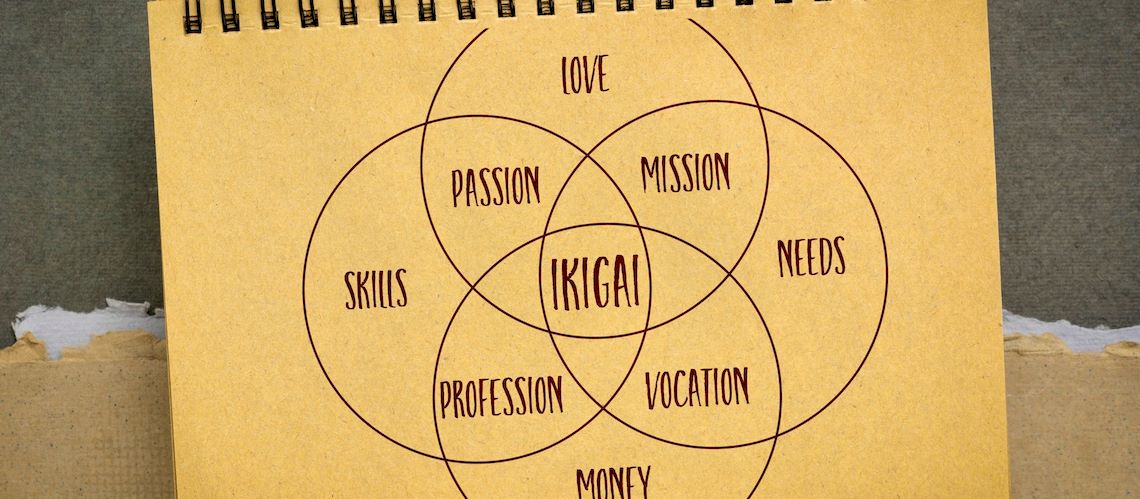Ikigai, a Japanese concept meaning “a reason for being,” represents a profound sense of purpose and fulfillment essential to living a meaningful life. Within the Excellence Nexus Framework—which focuses on achieving peak performance across six domains: Physical Peak, Mental Peak, Emotional Peak, Spiritual Peak, Prosperity Peak, and Impact Peak—ikigai plays a critical role in guiding individuals toward sustained excellence. Research shows that a strong sense of ikigai is linked to increased longevity, mental clarity, and overall life satisfaction (Sone et al., 2008; Shirai et al., 2022), making it an invaluable element in the pursuit of peak performance. This article examines how ikigai aligns with the Excellence Nexus Framework, supporting individuals in reaching their highest potential in all areas of life.
Application in Excellence Nexus
Ikigai contributes directly to each of the six peaks of the Excellence Nexus framework, enabling individuals to perform at their best by fostering balance, fulfillment, and growth.
- Physical Peak: Ikigai promotes a proactive approach to physical health, motivating individuals to adopt behaviors that enhance well-being. Studies show that those with a strong sense of ikigai engage in regular exercise and maintain balanced diets, which contributes to physical vitality (Okuzono et al., 2022; Shirai et al., 2022). Additionally, research on Japanese older adults indicates that ikigai is linked to lower cardiovascular risk and extended longevity, especially among those with higher health literacy (Goto, 2024; Sone et al., 2008).
- Mental Peak: Ikigai nurtures intellectual engagement and cognitive development, critical to achieving sustained mental clarity and growth. Research has found that individuals with a sense of purpose report higher life satisfaction and are more likely to pursue cognitive challenges, which can protect against cognitive decline (Shirai et al., 2022). Furthermore, Tomioka et al. (2016) found that older adults with a strong sense of ikigai demonstrated better cognitive health, reinforcing that mental engagement aligned with one’s purpose has long-term cognitive benefits.
- Emotional Peak: Ikigai supports emotional resilience, allowing individuals to navigate stress and adversity with greater stability. Wilkes et al. (2022) demonstrated that individuals with a strong sense of ikigai experience lower levels of anxiety and depression, contributing to a balanced emotional state essential for peak performance. Moreover, during crises, such as the 2011 earthquake in Japan, ikigai was a key factor helping people regain emotional balance and cope with stress (Ishida, 2011).
- Spiritual Peak: Spiritual well-being is central to ikigai, as it fosters a connection between personal purpose and a sense of community. According to Seko and Hirano (2021), ikigai often emerges from social connections and community contributions, reinforcing spiritual harmony. Additionally, Shirai et al. (2006) suggest that those with a well-defined ikigai derive satisfaction from their ability to contribute meaningfully to society, enhancing spiritual fulfillment in alignment with the Excellence Nexus.
- Prosperity Peak: Ikigai can drive prosperity by aligning professional pursuits with personal passions and strengths. Studies indicate that individuals who integrate ikigai into their work are more likely to experience job satisfaction and avoid burnout, contributing to long-term professional success (Randall, 2023; Sartore, 2023). This alignment allows individuals to pursue prosperity in a manner that sustains motivation and personal fulfillment, ensuring a holistic approach to professional achievement.
- Impact Peak: Making a meaningful impact on others is closely connected to one’s ikigai. Research by Eshak et al. (2023) highlights that individuals who maintain a strong sense of purpose show resilience amid work and family conflicts, enabling them to positively influence their communities. By cultivating ikigai, individuals can expand their capacity to create lasting change and achieve excellence in the impact peak of the framework.
Benefits within Excellence Nexus
The benefits of ikigai extend across all six domains of the Excellence Nexus Framework, supporting peak performance in physical, mental, emotional, spiritual, professional, and social dimensions.
- Physical Peak: Ikigai motivates individuals to engage in health-promoting behaviors, enhancing vitality and longevity (Okuzono et al., 2022; Goto, 2024).
- Mental Peak: Encouraging curiosity and intellectual engagement, ikigai fosters cognitive growth and mental clarity (Shirai et al., 2022; Tomioka et al., 2016).
- Emotional Peak: By reducing anxiety and depression, ikigai enhances emotional resilience, promoting stability (Wilkes et al., 2022).
- Spiritual Peak: Pursuing purpose through ikigai nurtures spiritual harmony by fostering meaningful social connections and community involvement (Seko & Hirano, 2021; Shirai et al., 2006).
- Prosperity Peak: Aligning career pursuits with passions through ikigai promotes job satisfaction and professional success (Randall, 2023; Sartore, 2023).
- Impact Peak: With a focus on purpose, ikigai expands one’s potential to contribute positively to society, creating a lasting impact (Eshak et al., 2023).
How to Integrate Ikigai in the Excellence Nexus
To leverage ikigai for peak performance within the Excellence Nexus framework, individuals can take the following steps:
- Physical Peak: Cultivate health-promoting habits that align with your ikigai, such as engaging in regular physical activities and adopting a mindful approach to nutrition (Okuzono et al., 2022; Goto, 2024).
- Mental Peak: Pursue intellectual interests and cognitive challenges aligned with your purpose, whether through professional development, creative projects, or personal hobbies (Shirai et al., 2022; Fido et al., 2019).
- Emotional Peak: Reflect on your purpose to build emotional resilience, using ikigai as a source of strength during stressful times (Wilkes et al., 2022; Ishida, 2011).
- Spiritual Peak: Deepen connections with your community and engage in contributions that resonate with your ikigai, fostering fulfillment and spiritual well-being (Seko & Hirano, 2021; Shirai et al., 2006).
- Prosperity Peak: Align professional pursuits with your ikigai by choosing or shaping career paths that reflect your values and strengths, enhancing satisfaction and reducing burnout (Randall, 2023; Sartore, 2023).
- Impact Peak: Use your ikigai as a foundation to drive meaningful contributions to society, whether through volunteer work, leadership, or creative innovation, expanding your positive influence (Eshak et al., 2023).
Conclusion
Ikigai is a transformative concept that enhances the Excellence Nexus Framework, empowering individuals to achieve peak performance across all six domains. By fostering a deep sense of purpose and alignment, ikigai supports resilience, vitality, and personal growth, enabling individuals to reach their highest potential. Integrating ikigai into one’s daily life leads to sustained excellence, fulfillment, and long-term well-being across physical, mental, emotional, spiritual, professional, and social peaks.
References:
Garcia, H., & Miralles, F. (2017). Ikigai: The Japanese Secret to a Long and Happy Life. Penguin Books.
Buettner, D. (2010). The Blue Zones: Lessons for Living Longer from the People Who’ve Lived the Longest. National Geographic Society.
Sone, T., Nakaya, N., Ohmori, K., Shimazu, T., Higashiguchi, M., Kakizaki, M., … & Tsuji, I. (2008). Sense of life worth living (ikigai) and mortality in Japan: Ohsaki Study. Psychosomatic Medicine, 70(6), 709-715.
Belice, T., Gursoy, U., Murakami, İ., Demir, İ., Yüksel, A., & Akçiçek, S. (2022). The Turkish version of the Ikigai-9 scale: a validity and reliability study. https://doi.org/10.21203/rs.3.rs-1303957/v1
Eshak, E., Baba, S., Yatsuya, H., Iso, H., Hirakawa, Y., Mahfouz, E., … & El-Khateeb, A. (2023). Work and family conflicts, depression, and “ikigai”: a mediation analysis in a cross-cultural study between Japanese and Egyptian civil workers. Journal of Epidemiology, 33(7), 360-366. https://doi.org/10.2188/jea.je20210338
Fido, D., Kotera, Y., & Asano, K. (2019). English translation and validation of the Ikigai-9 in a UK sample. International Journal of Mental Health and Addiction, 18(5), 1352-1359. https://doi.org/10.1007/s11469-019-00150-w
Goto, T. (2024). Biopsychosocial consideration of ikigai in older adults in Japan through a cross-sectional study. Geriatrics, 9(3), 78. https://doi.org/10.3390/geriatrics9030078
Huwae, A. (2023). Empowering adolescents in orphanages: unveiling life meaning through ikigai training. Counsenesia Indonesian Journal of Guidance and Counseling, 4(2), 75-84. https://doi.org/10.36728/cijgc.v4i2.2546
Ishida, R. (2011). Enormous earthquake in Japan: coping with stress using purpose-in-life/ikigai. Psychology, 2(8), 773-776. https://doi.org/10.4236/psych.2011.28118
Kinoshita, S., Hirooka, N., Kusano, T., Saito, K., & Nakamoto, H. (2020). Does improvement in health-related lifestyle habits increase purpose in life among a health literate cohort? International Journal of Environmental Research and Public Health, 17(23), 8878. https://doi.org/10.3390/ijerph17238878
Okuzono, S., Shiba, K., Kim, E., Shirai, K., Kondo, N., Fujiwara, T., … & VanderWeele, T. (2022). Ikigai and subsequent health and wellbeing among Japanese older adults: longitudinal outcome-wide analysis. The Lancet Regional Health – Western Pacific, 21, 100391. https://doi.org/10.1016/j.lanwpc.2022.100391
Randall, N. (2023). Understanding the connection among ikigai, well-being, and home robot acceptance in Japanese older adults: mixed methods study. JMIR Aging, 6, e45442. https://doi.org/10.2196/45442
Sartore, M. (2023). An integrated cognitive-motivational model of ikigai (purpose in life) in the workplace. Europe’s Journal of Psychology, 19(4), 387-400. https://doi.org/10.5964/ejop.9943
Seko, K., & Hirano, M. (2021). Predictors and importance of social aspects in ikigai among older women. International Journal of Environmental Research and Public Health, 18(16), 8718. https://doi.org/10.3390/ijerph18168718
Shirai, K., Iso, H., Fukuda, H., Toyoda, Y., Takatorige, T., & Tatara, K. (2006). Factors associated with “ikigai” among members of a public temporary employment agency for seniors (silver human resources centre) in Japan; gender differences. Health and Quality of Life Outcomes, 4(1). https://doi.org/10.1186/1477-7525-4-12
Shirai, K., Kimura, T., Ikehara, S., Tamakoshi, A., & Miyazaki, J. (2022). Purpose in life (ikigai) and employment status in relation to cardiovascular mortality: the Japan Collaborative Cohort Study. BMJ Open, 12(10), e059725. https://doi.org/10.1136/bmjopen-2021-059725
Tanno, K., Sakata, K., Ohsawa, M., Onoda, T., Itai, K., Yaegashi, Y., … & Tamakoshi, A. (2009). Associations of ikigai as a positive psychological factor with all-cause mortality and cause-specific mortality among middle-aged and elderly Japanese people: findings from the Japan Collaborative Cohort Study. Journal of Psychosomatic Research, 67(1), 67-75. https://doi.org/10.1016/j.jpsychores.2008.10.018
Tomioka, K., Kurumatani, N., & Hosoi, H. (2016). Relationship of having hobbies and a purpose in life with mortality, activities of daily living, and instrumental activities of daily living among community-dwelling elderly adults. Journal of Epidemiology, 26(7), 361-370. https://doi.org/10.2188/jea.je20150153
Watanabe, T. (2024). Effects of changes in frequency of going out during the COVID-19 pandemic on ikigai (sense of purpose in life) and mental health in middle-aged and older adults in Japan. Journal of Cross-Cultural Gerontology, 39(2), 125-135. https://doi.org/10.1007/s10823-024-09504-x
Wilkes, J., Garip, G., Kotera, Y., & Fido, D. (2022). Can ikigai predict anxiety, depression, and well-being? International Journal of Mental Health and Addiction, 21(5), 2941-2953. https://doi.org/10.1007/s11469-022-00764-7
Şimşek, O., Kaya, A., Çevık, O., & Koçak, O. (2023). How is the problematic smartphone use affected by social support? A research model supported by the mediation of ikigai. Current Psychology, 43(2), 1102-1117. https://doi.org/10.1007/s12144-023-04362-1




